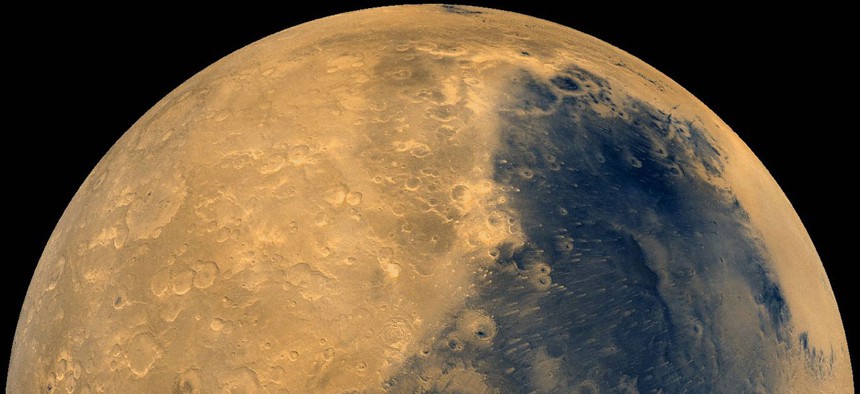
NASA file photo
Odyssey, the Longest-Surviving Mars Orbiter, Celebrates 15 Years
A NASA orbiter marks a milestone.
NASA has specific rules about naming its missions. In 2000, a naming committee reviewed more than 200 suggestions for a spacecraft bound for Mars the following year. The group settled on Astrobiological Reconnaissance and Elemental Surveyor, or ARES, like the Greek god of war. The Roman version of that god is Mars, so the name seemed appropriate. But not everyone was on board.
“It was not very compelling, was awfully aggressive, and as an acronym was pretty nerdy,” explains Scott Hubbard, a Stanford University professor who served as NASA’s first Mars program director at the time, in his 2012 book on exploring the red planet.
Hubbard and others pointed out that the year the spacecraft was set to be launched was conveniently in the title of one of the most iconic science-fiction books, Arthur C. Clarke’s 2001: A Space Odyssey . The naming committee said it had indeed considered “Mars Odyssey,” but rejected it over copyright concerns. Still, the name was pretty good, so NASA emailed Clarke, who lived in Sri Lanka, and asked for permission. He enthusiastically agreed.

Mars Odyssey launched this week 15 years ago, with the task of measuring the amount of hydrogen just under the Martian surface—which could indicate the presence of water—studying surface minerals and geological processes, and measuring the planet’s radiation environment. The craft reached Mars 200 days later and slowly settled into its orbit. The orbiter completed its formal, $297 million mission in 2004, but it’s still humming along. Odyssey holds the record for the longest-surviving active spacecraft around Mars.
“The spacecraft is remarkably healthy, and we have enough fuel to last for several more years,” said David Lehman, Odyssey’s project manager who works with NASA’s Jet Propulsion Laboratory, in a statement marking the anniversary.
Odyssey detected large amounts of hydrogen in Mars’s subsurface in 2002, which suggested liquid water may have existed there. It would be another 13 years before NASA announced it had confirmed flowing water on the planet. Odyssey’s observations of the landscape helped scientists determine landing sites for future missions. These days, the orbiter helps relay communications between Mars rovers and Earth.
Odyssey was a high-stakes mission. Since the first attempt at a Mars mission by the Soviet Union in 1960, various countries had launched 40 spacecraft to the planet, and only about a third were successful. In January 1999, NASA had lost communication with a lander and two probes when they reached Mars. Later that year, a NASA orbiter dispatched to study the planet’s climate burned up in its atmosphere. Odyssey’s success was a relief.
Seven NASA missions have successfully made it to Mars in the years since Odyssey left Earth. For some of those missions, the space agency left the naming up to kids: Spirit, Opportunity, and Curiosity were christened by the winners of essay contests—no copyright required.
NEXT STORY: What If The FBI Tried To Crack an Android Phone?







